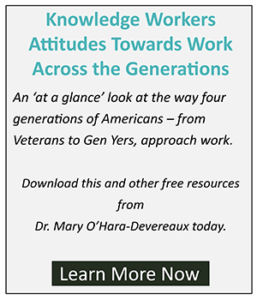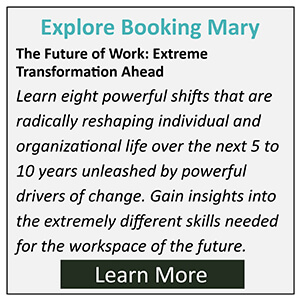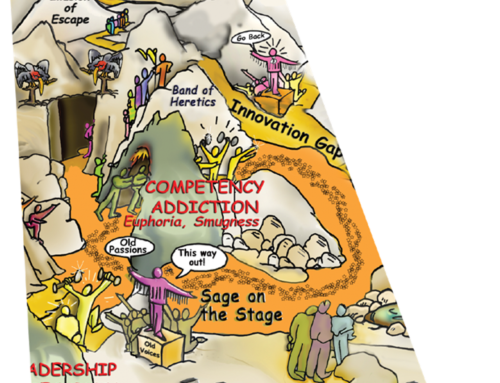With rapid changes occurring throughout the Badlands and beyond, today’s knowledge workers must go beyond the current needs of the economy and focus on the skills organizations will need in the future.
Both macro-drivers and disruptive shifts can provide key indicators of what the future of work will look like and what specific skills will be most important. But moreover, here are the 6 skills I believe will be most important in the future for knowledge workers:
 1. Social Intelligence
1. Social Intelligence
Social intelligence is the capability to both read the thinking and emotions of others quickly in each context, and connect deeply with them, to stimulate reactions and persuade them to engage with you in the pursuit of the desired results.
 Workers of the future will see a shift from the dominance of technical intelligence to social intelligence as a sought-after aptitude. The socially intelligent leader must change the context in ways that encourage collaboration across these focused but dispersed groups, to create the innovations key to the organization’s success. These new contexts must support knowledge work dominated by Velcro relationships. Like the material itself, these are relationships that come together quickly and are very strong and useful, but which can also break apart quickly leaving no damage.
Workers of the future will see a shift from the dominance of technical intelligence to social intelligence as a sought-after aptitude. The socially intelligent leader must change the context in ways that encourage collaboration across these focused but dispersed groups, to create the innovations key to the organization’s success. These new contexts must support knowledge work dominated by Velcro relationships. Like the material itself, these are relationships that come together quickly and are very strong and useful, but which can also break apart quickly leaving no damage.
The best managers and leaders of the future will possess social intelligence so they and their teams can switch contexts quickly and connect deeply with others. This ability is called ‘the art of the deep bump.’ This is a person who, upon briefly ‘bumping’ into someone critical to their project, can form a relationship that resonates deeply enough to lead to productive and innovative solutions. It must be strong enough to assure that team members will not fall back into fragmented and dis-aggregated realities before the solutions have been delivered.
2. The Ability to Create Critical, Unique Insights
This is the ability to call higher thinking skills into action to help make a critical decision that requires new novel solutions in unexpected situations.
This ability includes the discovery of the broader significance and deeper meaning of these novel solutions that makes the new knowledge adaptable to a range of other unique and unexpected situations.
It begins with ‘sense-making’, or making sense of the unanticipated context of new information or experience. The person then must have the generative ability to create unique insights and novel solutions from this sense-making of the intersection of various data sources. Furthermore, this ability must be adaptive to various sources of data, fields of knowledge, and the unique people available in an organization as these unexpected situations arise over and over again. This is a skill that will help to differentiate us as human beings from the capabilities of smart machines, whose artificial intelligence falls short of this complex generative thinking. (See The 8 Macro-Drivers & Trends Transforming Work Part 2)
 3. Trans-Disciplinary
3. Trans-Disciplinary
This is the capability of an individual knowledge worker to understand, communicate, and create new ideas alone using his or her own knowledge from multiple disciplines while simultaneously solving problems.
This skill best represents the age of the combinatorial worker, where the most sought-after person is one who can integrate deep knowledge from more than one technical specialty as well as from social, anthropological, and environmental sources. The trans-disciplinary knowledge worker is then able to utilize this knowledge to analyze issues and develop novel solutions.
Two factors are important to clarify with this skill:
-
-
- First, it requires more than a cross-disciplinary approach of assembling several people from separate disciplines to solve problems or innovate. The demands of today’s new distributed context for work needs the efficiency of a trans-disciplinary worker frequently.
-
-
-
- Second, it is important that a combinatorial worker be fluent, and have true literacy in (rather than just familiarity) with the different disciplines they are engaging in during their creative thinking process.
-
4. Workspace — Design Architecture
Neuroscience research has enabled us to understand how different work environments mediate behavior and encourage certain types of thinking and execution of tasks. This can be now be applied to design environments that will be better suited to accomplish the different categories of desired tasks. This is especially important when creative thinking is paramount.
Organizations of the future will improve their innovation and productivity by engaging with workspace design architects who can design spaces and places frequently and rapidly that support the kind of thinking demanded of a certain task. This talent will be in high demand in the future, as it becomes a key component of maintaining competitive advantage.
 5. Cognitive Load-Management
5. Cognitive Load-Management
This is the capacity to quickly and effectively filter for information that is important and relevant to the moment.
The age of’ big data’ brings with it a lot of noise, and workers need to automatically apply techniques and tools so they are not overwhelmed by detail and the abundance of information not relevant to the task at hand. This is a skill to be used consciously, and semi-automatically, throughout the day, so that ongoing prioritizing, ranking, tagging of various pieces of information can be undertaken without it occupying time meant for other day-to-day needs and duties. This will be enabled in part by sensors that can measure the brain to determine overload is occurring and detail processing can be reduced to refresh the brain and alert the worker to the overload.
 6. Media Fluency
6. Media Fluency
The plethora of new media is transforming how we interact with one another at work and play. Their utility and accessibility is demanding that all knowledge workers become fluent in their use.
At the heart of this revolution is the ability to engage others through visually appealing and interactive content that they create. Access to user-friendly visual tool sets to create this content is rapidly becoming available to all workers and is increasingly easy to use. Of further importance is their effectiveness in deeper and more interesting communication.
An understanding and mastery of these tools is necessary for spurring creativity and innovation. Although it is not the official end of PowerPoint and other static forms of presentation, these tools will be used less frequently, especially when real engagement and persuasion to think and do things differently are the desired outcome.
Parting Thoughts…
The skills that have served us throughout this cycle of disruptive innovation to date are rapidly becoming obsolete. We must develop these new skill sets in order to survive and thrive as we navigate out of the Badlands. There will be greater emphasis on how we interact with technology and data, as well as the changing manner in which we interact with one another. For those with these capabilities, the future or work looks bright.



